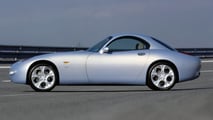We’re still rooting for Alfa Romeo to flourish and become a true rival to the German trifecta. The brand remains some distance from challenging BMW, Mercedes-Benz, and Audi, partly because parent company Stellantis is taking its time with the next-generation Giulia and Stelvio. Much like Audi’s effort to recapture its lost spark with a sports car, Alfa Romeo could use one of its own. Ideally, one that doesn’t cost millions of dollars like the 33 Stradale.
Sadly, the 8C and GTV revivals never materialized, and the diminutive 4C is long gone. A fresh start with a coupe could do wonders for the struggling brand’s image. Stellantis certainly has the means to make it happen. That brings us to this latest installment in our Concept We Forgot series: a coupe that made a splash at the 1996 Paris Motor Show.
Concept We Forgot
Welcome to Concept We Forgot, a series where we explore some of the wildest and most innovative concept cars throughout history—many of which you might not even remember.
Named after legendary Italian racing driver Tazio Nuvolari, the Nuvola concept previewed a new design language for Alfa Romeo. Penned by Walter de Silva, the striking coupe gave fans a glimpse of the brand’s future. The 156 debuted in 1997, followed by the 166 in 1998, and the 147 in 2000, serving as de Silva’s last Alfa before he moved to the Volkswagen Group to work on the Bugatti Veyron concept.
At the time, Alfa described the Nuvola as an "extreme version of a coupe," designed strictly for two occupants nestled in bucket seats. It was roughly the same size as the outgoing Toyota Supra, with bumpers integrated into the body to reduce shut lines. The 18-inch wheels were wrapped in bespoke Michelin tires with a tread pattern developed specifically for the concept.
But there was more to the Nuvola than its curvaceous form. Alfa Romeo envisioned reviving the long-lost art of coachbuilding by selling the car’s underpinnings to independent builders. The plan was to homologate the chassis and sell it to body shops that would then create their own versions, ranging from wagons and convertibles to 2+2 coupes and even off-roaders.

The idea was that homologation would be easier for these companies since Alfa had already done most of the groundwork. Interestingly, Alfa didn’t rule out selling such cars through its own dealer network, even considering applying its badge to those that stayed true to "the Alfa Romeo spirit." The cars would've been based on a spaceframe chassis with all-round independent suspension.
Beneath the TVR-esque body was solid engineering. Power came from a twin-turbocharged 2.5-liter V-6 producing 296 horsepower and 285 pound-feet of torque, sent to all four wheels through a six-speed manual gearbox. The Nuvola could sprint from 0 to 60 miles per hour in six seconds flat, and reach a top speed of 174 mph.
Alfa Romeo saw it as "the ideal forerunner of a new generation of limited-series sports cars, which could differ greatly from one another." De Silva himself even admitted that the Nuvola could have helped revive the Alfa brand, which was struggling at the time. In an interview with The Classic Car Trust, he said:
'Out of every ten projects you do, only one makes it to production… It’s a shame, before the arrival of the 146 and the 147, Alfa needed a halo model; the Nuvola had everything Alfa needed to put it fairly and squarely back on the map.'


Sadly, that vision never materialized, and the Nuvola remained a one-off that merely reset the brand’s design language. While it previewed a modern styling direction, it also paid homage to the past. Its long hood, for instance, echoed the 1930s 8C and the 1950s 2000 Sportiva prototype.
In many ways, the Nuvola was Alfa Romeo’s equivalent of Audi’s Concept C. But while Audi is following through with a production version coming in 2027, Alfa will stick mostly to SUVs. A relatively affordable halo car could attract more people to showrooms, and even if they end up buying a Tonale or Stelvio, it would still be a win for the brand.
To Alfa Romeo’s credit, it hasn’t abandoned the dream entirely. The company recently announced a partnership with fellow Stellantis brand Maserati to build "few-off" cars. However, those are expected to carry price tags closer to the 33 Stradale’s, putting them out of reach for most enthusiasts.
1996 Alfa Romeo Nuvola concept














